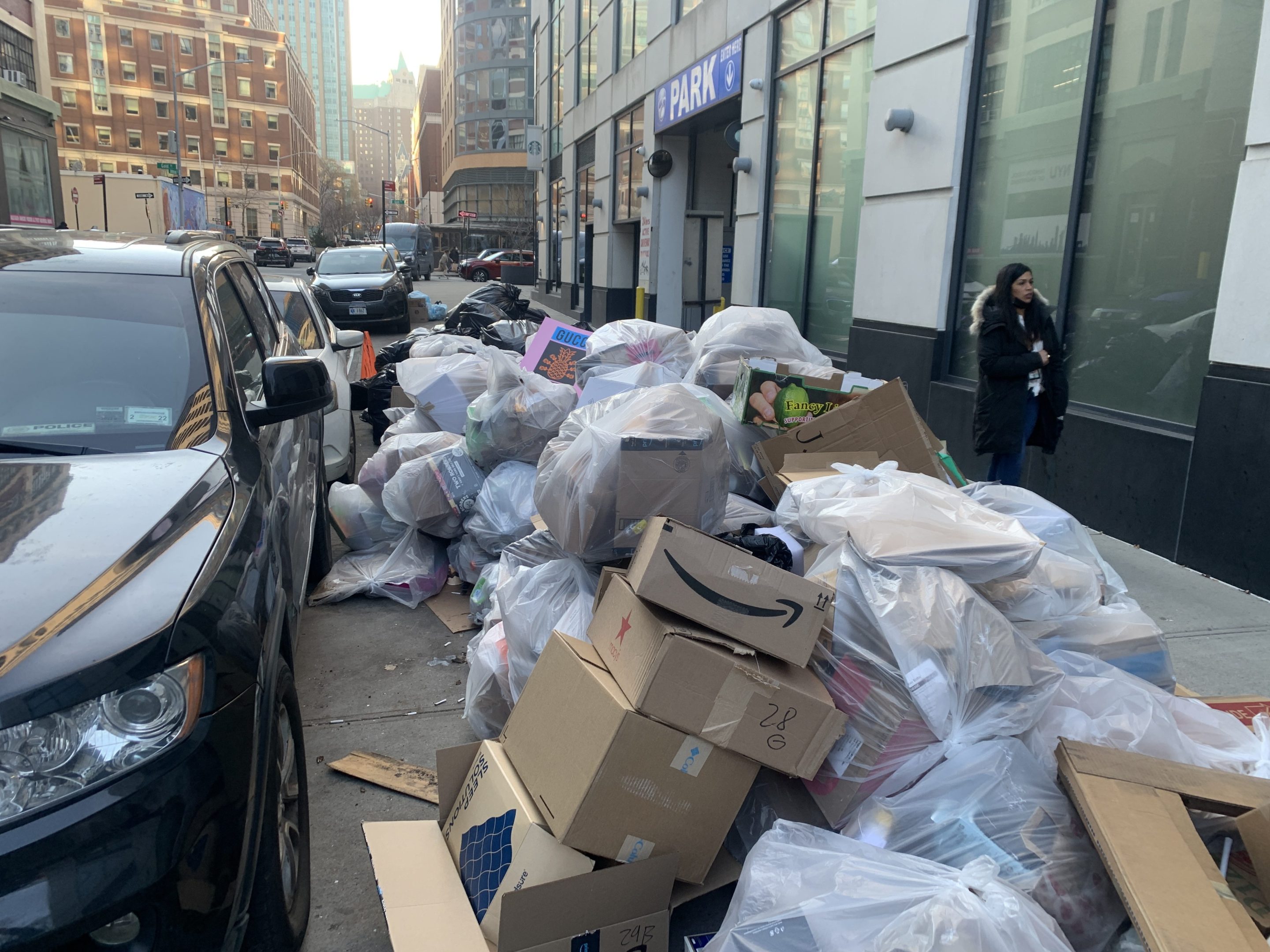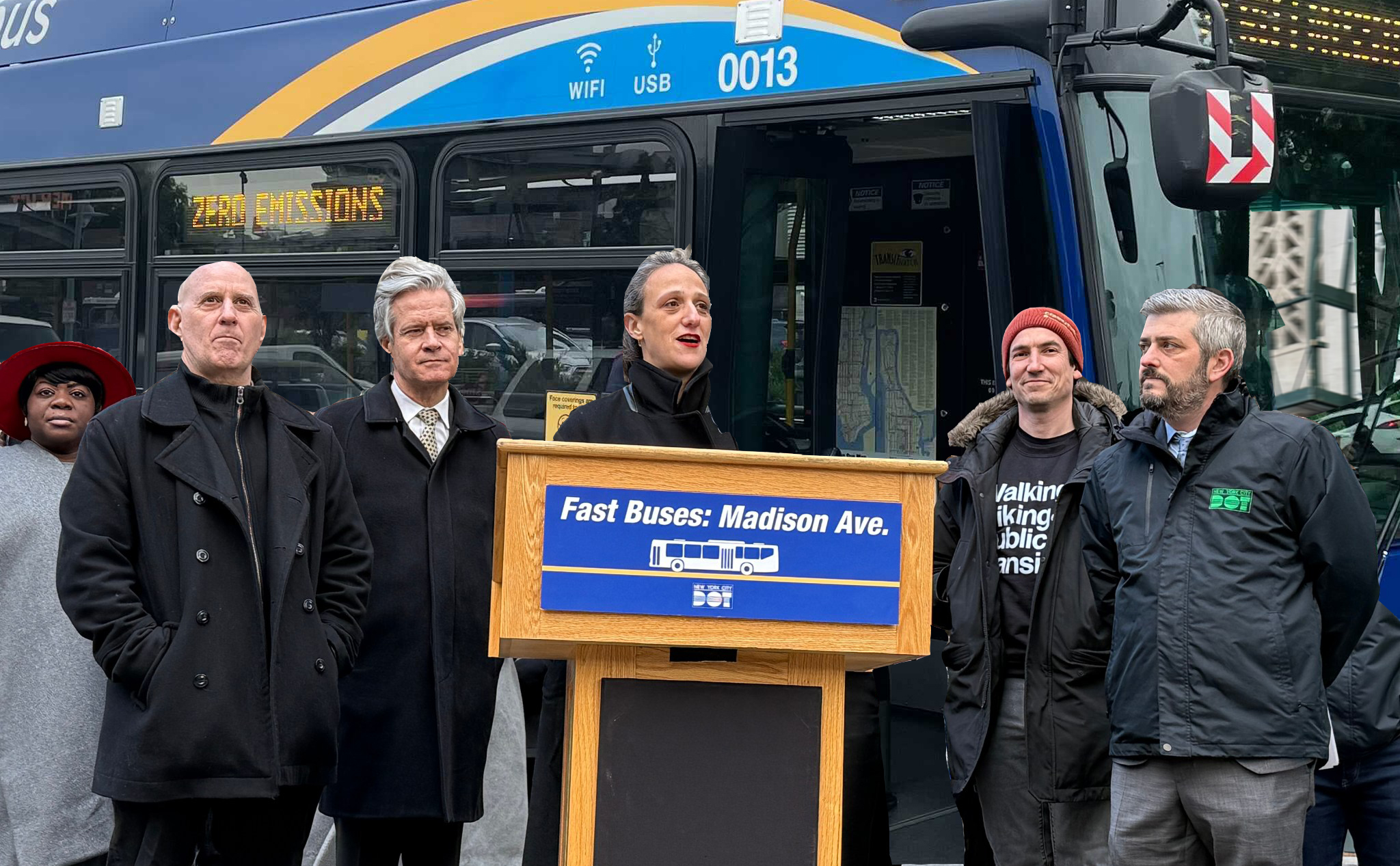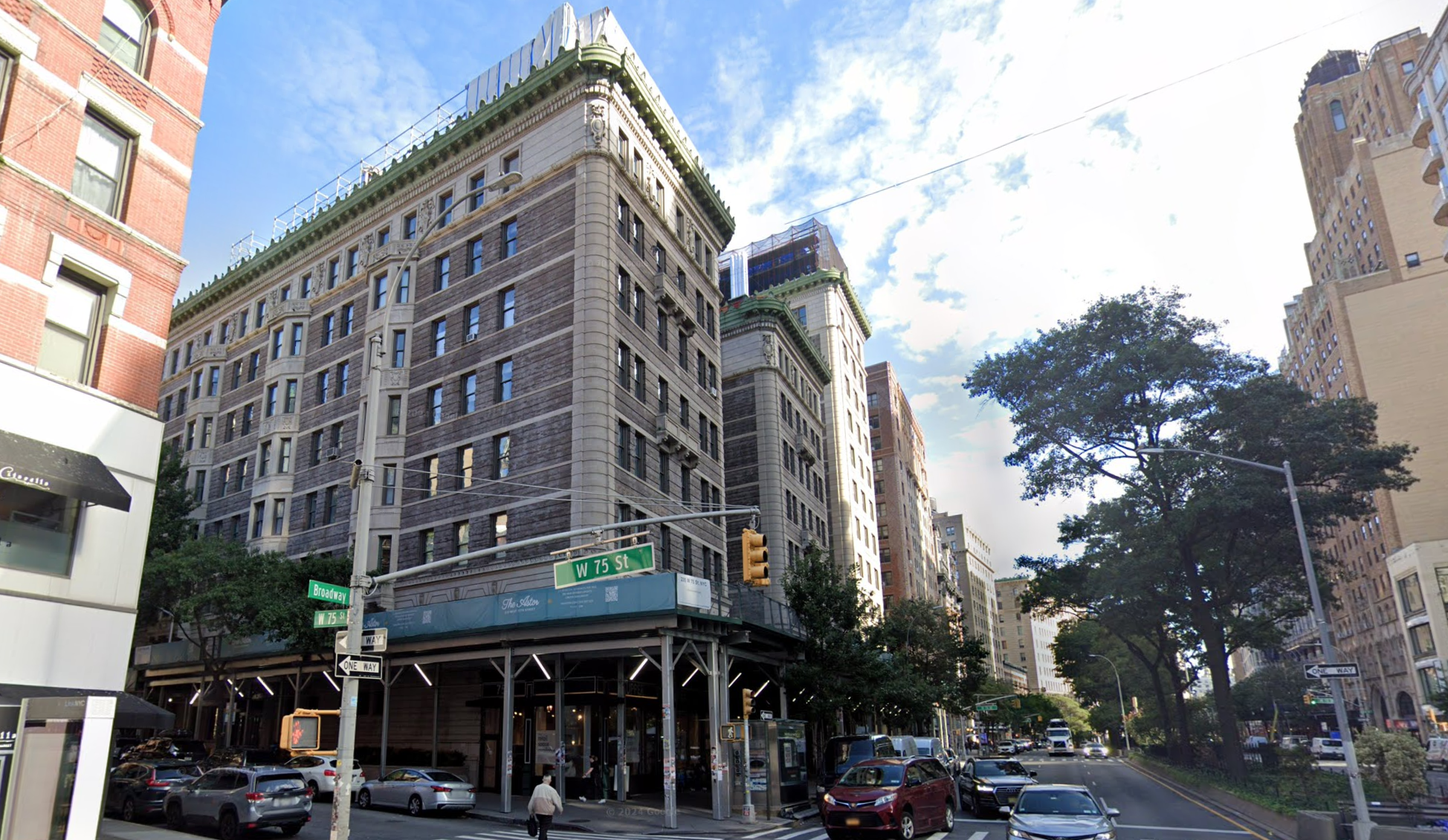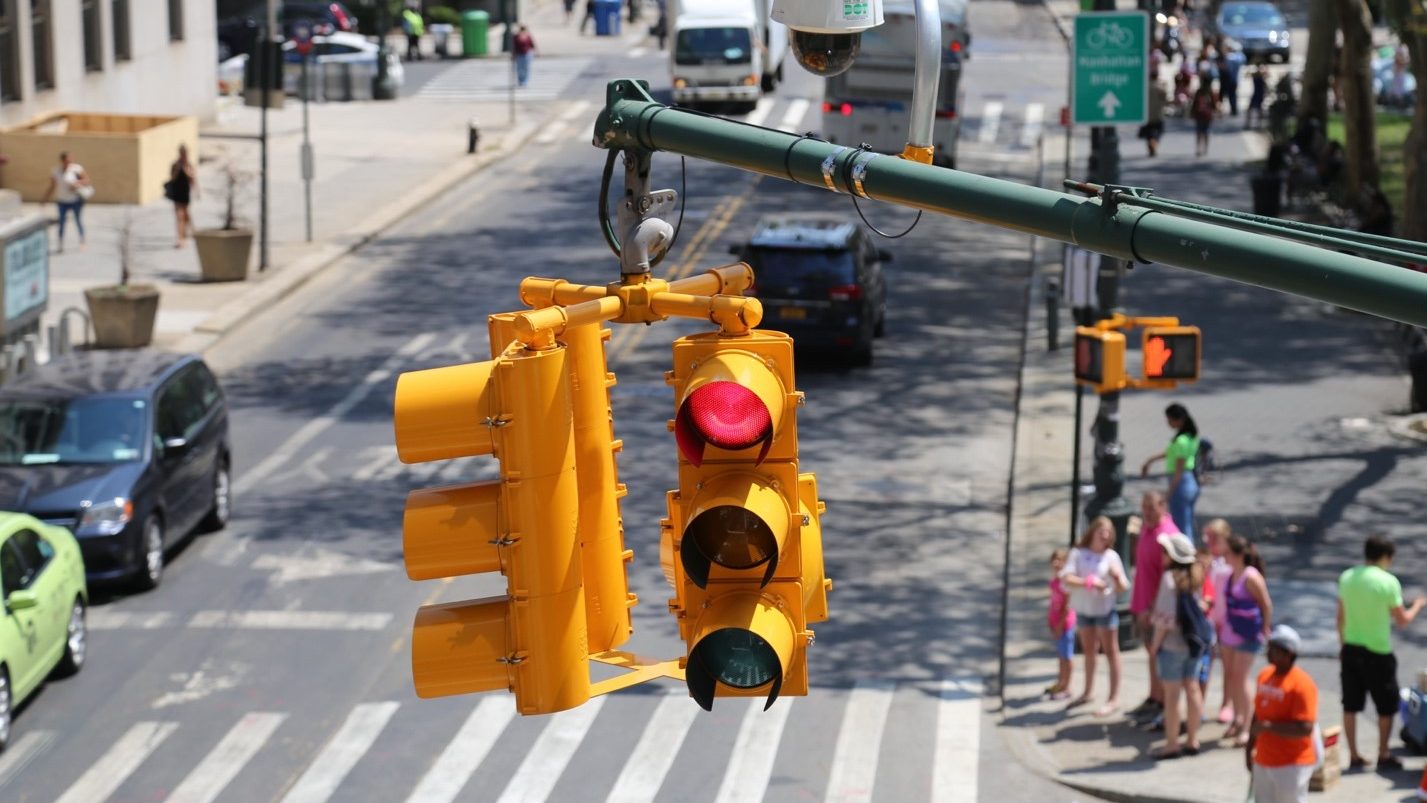It wasn’t quite 4 p.m. on a recent Friday afternoon, but the rats on Beaver Street were having the Early Bird Special.
“Every single time I’m on this block, it’s like this,” Ali Marconi, a Financial District resident, told Streetsblog, as vermin darted in and out of the black plastic buffet put out by the luxury residential building 63 Wall Street. “The bags take up the whole sidewalk, you can’t even use the sidewalk. It’s disgusting. It’s terrible.”
For Sunil Vyas and his young daughter Layla, trash days offer a sort of grim obstacle course.
“I walk my daughter to school every morning and we have to weave in and out, or cross the street, or walk in the middle of the street,” Vyas said. “It’s a hazard. It really is.”
These scenes play out every day in every borough. The mountains of garbage bags waiting for collection that clog our curbs and sidewalks and serve as edible yurts for millions of rats are now as much of a New York City institution as the dollar slice and 24-hour subway service.
How did this happen? How did the single unifying issue for 8.5 million people — getting unsightly and unsanitary trash out of the public square — become a sorry example of New York exceptionalism? Why are black garbage bags on the sidewalk New York’s 5 o’clock shadow?
In conversations with policy experts, architects, elected officials, and former city workers, one word came up repeatedly to describe the Big Onion’s relationship with garbage: “inertia.” The greatest and richest city in the world is being embarrassed by other municipalities when it comes to nearly every facet of how we generate, sort, store, and recycle the more than 12,000 tons of waste handled by the Sanitation Department every day.
Take New York’s approach to residential waste containerization. Big cities in France, South Korea, Argentina, and the Netherlands use below-grade containers, pneumatic tubes, and street-level sorting bins to keep their streets clean and their trash pickup efficient.
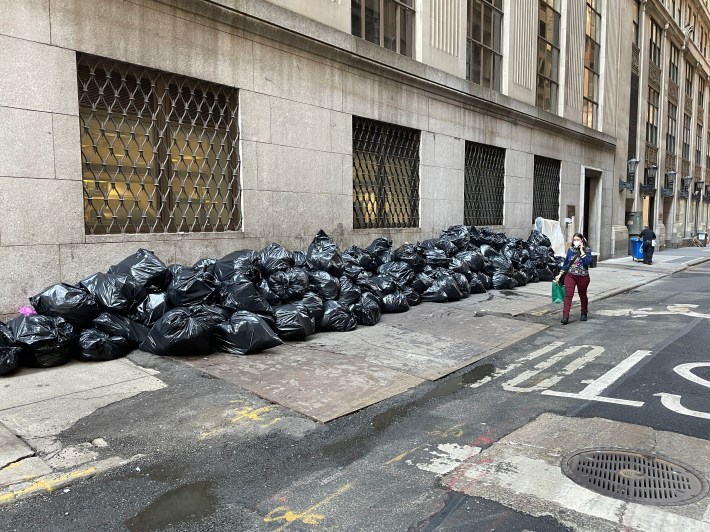
You don’t even have to leave the city to find examples of a better way: Roosevelt Island’s 16 residential buildings have used pneumatic tubes and compactors to store and move waste since the mid-1970s. Battery Park City, which is overseen by a state entity, also uses compactors and large containers to keep that neighborhood’s streets clean.
Meanwhile, New York City’s two-year-old Clean Curbs pilot program, which would allow some businesses to containerize their waste, has not gotten out of the planning stage. At a City Council committee meeting on March 4, DSNY confirmed that when Clean Curbs does launch in the coming months, it will be “very small-scaled, probably one block.”
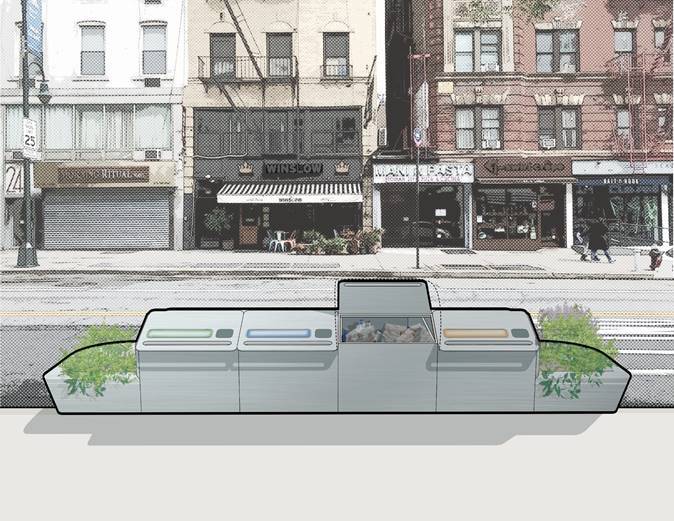
Paris has roughly the same density as Manhattan, yet little of the hesitancy to tackle the problem with large containers for recyclables on the street, said Clare Miflin, an architect and the founder of the Center for Zero Waste Design.
“They piloted 40, then they assessed it, then they did procurement for a few thousand. They did it properly, whereas we’ve done these tiny, incremental things like Clean Curbs,” Miflin said. “Like, okay, a private entity can do one, but why isn’t the city piloting a load of them?”
Rat-resistant bins are just a part of the solution, because they cannot handle the waste produced from the large developments where many New Yorkers live. To truly get a handle on our trash problem, we must stop sending so much of it to landfills and incinerators (which are typically in low-income communities across America), at an annual cost of more than $430 million to New York’s taxpayers and an incalculable cost to the planet. Here again we see the inertia.
The city is nowhere close to meeting its goal, set in 2015 by then-Mayor de Blasio, of sending zero waste to landfills by 2030. It’s not even close to its goal of a 33-percent diversion rate — the percentage of waste that is recycled instead of sent to a landfill or incinerator — set by Local Law 40 in 2010. DSNY’s overall diversion rate stood at 17.6 percent in FY 2021, almost exactly where it was in 2017 (and the most recent report shows that it has dipped to 16.7 percent). Diversion rates in Seattle, Los Angeles, and San Francisco are 60 percent, 76 percent, and 80 percent, respectively.
Sanitation Department spokesperson Vincent Gragnani said the primary cause for the drop was pandemic-related budget cuts, and that it represented a short-term trend. Yet Mayor Adams recently proposed more cuts to the agency: $47.8 million in reductions to programs like composting and waste basket pickup.
“What’s happening in New York is business as usual,” said Elizabeth Balkan, a senior policy adviser to Michael Bloomberg and the director of policy for the Sanitation Department from 2014 to 2018. “It’s been happening for 30 years in waste policy, and I really don’t see any change.”
Hooked on plastic
Like parking private cars on the street, storing trash in bags on the curb used to be illegal in New York City. Metal cans were mandated by the Health Department because they kept garbage out of sight and away from rats. Ironically, it took a Sanitation strike to change the way New Yorkers took out the trash.
For nine days in early 1968, 10,000 of New York’s Strongest refused to show up while they demanded a $600 annual raise. Union head John DeLury was sent to jail for not ending the strike, and Gov. Nelson Rockefeller threatened to send in the National Guard. DSNY’s office was flooded with angry messages. “What the hell’s going on in Fun City?” one caller snarled.
On a tour of the Lower East Side, Mayor John Lindsay passed “accumulations of open garbage that were sometimes chest-high,” the New York Times reported. “The streets were littered with egg shells, orange rinds, coffee grounds, empty beer cans and milk cartons. ‘This is the worst I’ve seen,’ said the mayor, turning the corner of Avenue C and East Third Street.”
As the metal bins overflowed, the chemical industry donated 200,000 plastic bags for residents to store their garbage. Lindsay had agreed to a pilot for trash bags the year before, but the strike allowed New Yorkers to fully appreciate their advantages. They were much quieter than the long-hated Oscar the Grouch containers, and Sanitation workers loved that they were easier to lift and move around. Three years later, the city formally made trash bags a central part of garbage collection.
“[New Yorkers] are the ones who made their use more widespread,” said Benjamin Miller, an environmental policy consultant who wrote DSNY’s first Solid Waste Management plan in 1992 as the agency’s director of policy planning, and an expert on the history of trash in New York City.
Asked to diagnose the city’s current dilemma, Miller said, “It’s a question of, simply, inertia, lack of imagination and motivation and prioritization, and the fact that there’s a silo system between non-interacting agencies.”
To illustrate this last point, Miller, who is also part of the Center for Zero Waste Design, said that several years ago he met with representatives from the Department of Transportation to talk about placing containers to store waste on the street to address the plastic bag issue.
“They said, ‘Do you realize that we have never had this conversation with Sanitation?’” Miller recalled. “This topic had never been broached between these two agencies. And you would think that Sanitation and DOT would perceive a shared problem that they both have responsibility for and somehow coordinate.” (Gragnani, the DSNY spokesperson, said they “regularly work” with the DOT, and pointed to the slow-moving Clean Curbs pilot as an example.)
Another obstacle to speeding along waste containerization is the city’s garbage truck fleet. To efficiently pick up large containers of waste (for example, a 100-unit residential building currently produces enough landfill refuse to fill five 400-gallon containers every three days), the trucks need to have mechanical arms capable of lifting large containers. The majority of DSNY’s fleet are rear-loading trucks without arms. Just 10 percent of the roughly 12,000 tons of refuse that Sanitation picks up every day is stored in a large container — a 2-percent increase from 1992, which was 30 years ago.
Miflin, whose group helps property owners strategize better ways to handle their waste, described one client with 700 residential units in the Financial District situated on a block with a total of 1,600 units. “There’s 1,600 bags put out on the block. We timed it, it takes DSNY an hour and a half to pick up with all the different trucks. If they used containers it would be so much quicker.”
Gragnani told Streetsblog that there is no “silver bullet” technological solution to picking up trash more efficiently. “We want to test new technology – and we do. But the best way to have there be less trash is for people to produce less trash, to sort it properly, and for services to be properly allocated.”
Doing the right thing is impossible
Even if a property owner is starting from scratch and wants to store trash differently, the city’s regulations make it exceedingly difficult. A new skyscraper at 80 Flatbush Ave. will be the city’s first fully electric tower when it’s completed in 2024, and the Downtown Brooklyn complex will house two energy-efficient “passive” schools and 440 residential units.
“Sustainability is a central focus of everything we do,” David McCarty, a vice president at Alloy, the development firm behind the project. “From the beginning we have also thought a lot about trash.”
The 840-foot skyscraper is designed to have separate chutes for recycling and landfill waste, as well as compost bins on every floor. What happens to the waste after the residents sort and dispose of it? Developers are essentially given a binary choice: The trash can sit in a dank room until it’s time for staff to wheel it out onto the curb, or it can go into large roll-on, roll-off containers (RoRos, in industry parlance) that sit in a loading dock until a truck comes to empty them out.
RoRos, which are a minimum of 23 feet long, work well in some large residential complexes, but they are not ideal on public streets in dense neighborhoods because they require huge loading docks, which present a danger to people on the sidewalk and also eat into both ground floor retail space and curbside space that many drivers want for parking.
McCarty told Streetsblog that during the zoning process, the neighbors on the surrounding block strongly opposed having a huge loading dock at street-level in a pedestrian-heavy area. His firm is still committed to containerizing trash somehow, but that’s not something the city currently facilitates.
“Actually, like, how do you containerize waste and not have bags of trash on the sidewalk? That question was punted,” a frustrated McCarty said.
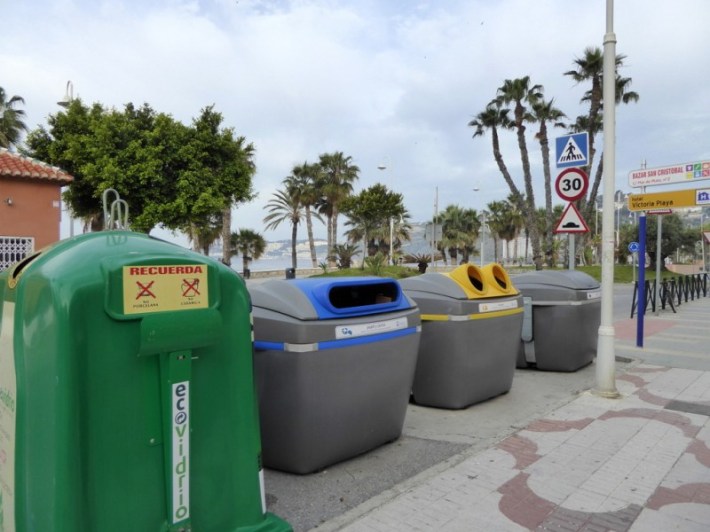
A rule proposed in 2020 that would require residential buildings with more than 300 units to store garbage off the street until collection day was never adopted; instead, DSNY requires buildings with 150 units or more to submit a waste management plan — which doesn’t require much except that the building remains “in accordance with all rules and regulations and may not impede the flow of pedestrian traffic or otherwise constitute a sidewalk obstruction, including maintaining, where practicable, eight feet of clear pedestrian space.”
So while Alloy has reserved street space outside of 80 Flatbush for containers, what those containers will look like (Will they be at grade? Underground? Wheeled out? Permanent?) is still unclear.
“The problem right now is, even if the developer really wants to do the right thing, there’s literally not a solution that the city will entertain,” McCarty said. “There needs to be other options on the table that people can choose from.”
Free trash pickup isn’t free
Yes, New York City can and should use containers to make trash collection more efficient and hygienic. But fixating on containerization is like adjusting your handlebars when you have two flat tires.
More than 30 percent of household trash that we send to landfills is organic waste that can be recycled as compost and converted into biogas, measures that the Independent Budget Office reported could bring in $35 million per year, in addition to lowering the costs of transporting the waste out of town. New Yorkers have paid for their water usage since the early 1980s, a built-in cost that encourages conservation, while garbage collection is treated as a sacred right secured by municipal taxes, which obscures the rising costs of dealing with all the waste destined for the landfill outside New York.
In other words, advocates say we need laws that force New Yorkers to recycle their organics (just like many businesses are currently forced to recycle theirs) and pay money for excessive trash pickup — the policy is often referred to as “pay-as-you-throw” (or “save-as-you-throw”) because the more waste you generate, the more you pay. One IBO study showed that a pay-as-you-throw program like those in LA and San Francisco would encourage New Yorkers to make less waste and save $400 million every year.
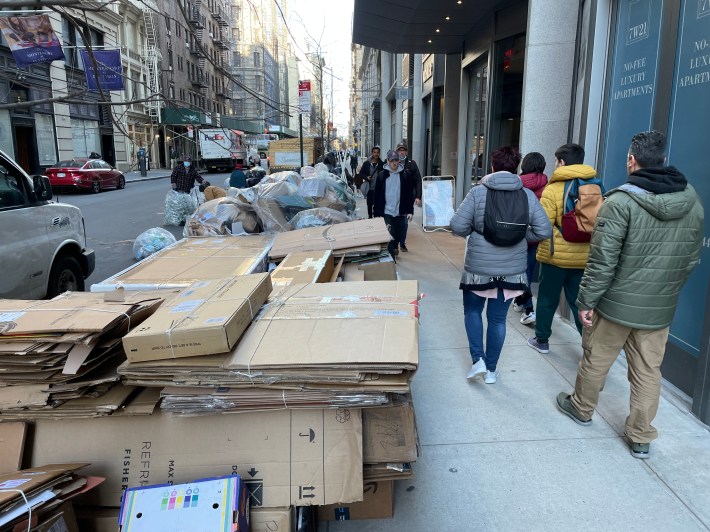
“The city will not achieve either a zero waste to landfill diversion goal, nor will the city see a dramatic increase in landfill diversion without things like save-as-you-throw and mandatory organics collection,” said Balkan, the former director of policy under Sanitation Commissioner Kathryn Garcia. “Without those measures, any improvements made will be on the margin, and quantitatively insignificant.”
DSNY knows this. “We are fully committed to finding a path towards zero waste. And we know that we can’t do that without a full citywide mandatory organics program,” Bridget Anderson, the current deputy commissioner for recycling and sustainability, told Streetsblog.
At the Council’s Sanitation committee meeting, Anderson cited the flagging organics numbers as proof that a major policy shift is necessary. Curbside residential organics collection is expensive and inefficient (and tempting for mayors to cut) because it is optional.
De Blasio never fulfilled his early promise to institute mandatory organics collection; former Council Speaker Corey Johnson is often credited with killing a proposal to charge New Yorkers for excessive trash pickup after he called the idea “insane.” The previous administration’s political capital on garbage was spent pushing through the consequential and long overdue commercial waste zones plan to make the private carting industry more efficient and reduce dangerous garbage truck traffic. (The waste zones are supposed to be fully in place by 2024.)
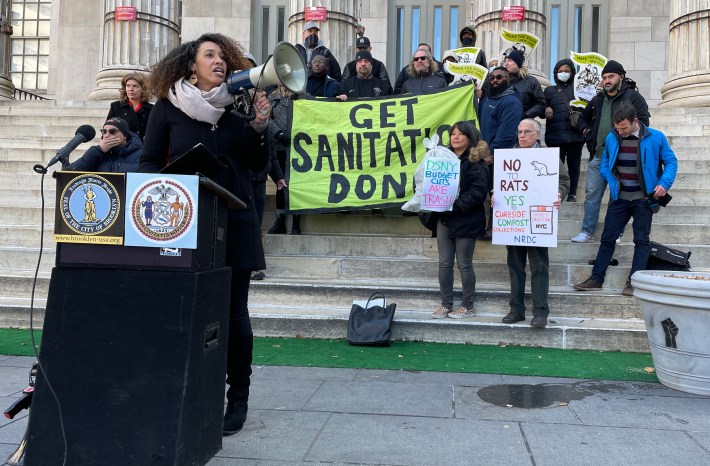
“We have full authority to implement both save-as-you-throw and mandatory organics recycling — two things we could do today if we had the political will,” Brooklyn Borough President Antonio Reynoso told Streetsblog. “There are people in the Department of Sanitation that are ready, willing, and able to get this done. Like, tomorrow.”
Change requires the Mayor to care
Will Mayor Adams, the proudly pro-business mayor, the “get stuff done” mayor, get these crucial things done? So far, he has sent mixed signals.
Days after he proposed his 3-percent across-the-board cuts to city agencies — including $47.8 million to Sanitation — he told comedian Seth Meyers that he was creating “an emerging market innovation hub” to look into trash containerization. “I don’t want to think outside the box. I want to destroy the darn box,” Adams said to cheers.
Asked to explain why he cut the expansion of the organics program, Adams called it a “broken system” because of its low participation rates, ignoring the fact that more cuts will only further hurt participation.
Balkan, the former director of policy at DSNY, notes that New York’s reputation as the trash bag capital of the world cuts against Adams’s message that he’s friendly to businesses. “It’s actually hurting businesses, and it’s hurting the economy, because it makes New York City a less desirable place to live and a less desirable place to run a business.”
Council Member Sandy Nurse, who represents parts of Bushwick, Brownsville, and East New York and is the current Sanitation committee chair, told Streetsblog that when she was canvassing her district to ask about public safety, residents’ “top safety concern was garbage and sanitation.”
“People want to feel like our neighborhood, particularly the neighborhoods that are low income, are nice, too. We deserve to have nice things and it doesn’t have to come at the expense of displacement or hypergentrification,” Nurse said. “We deserve the same level of service as every other zip code in the city.”
Nurse used to run a bicycle delivery compost nonprofit called BK Rot, and she supports policies like mandatory composting and save-as-you-throw. She is also aware of how massive and complicated the entire system is.
“We’re talking about big logistical challenges and certain things have to land before other things can be built upon that, before we understand how they interact,” Nurse explained. “And I think for people who are excited by zero waste and excited by sustainability, sometimes it’s not always easy to actually understand how much resources are involved in course correcting an entire sector.”
Before the more progressive members of the council can take up legislation on items like composting or the “skip the stuff” bill to cut back on wasted take-out utensils, they must first counter the Adams administration’s austerity budget. A state bill that would make organics collection in New York City mandatory is also pending, a measure for which DSNY Commissioner Ed Grayson has signaled his support.
During the Sanitation committee hearing, Nurse was adamant that the cuts to Sanitation “cannot be negotiated, must be fully funded,” and noted that the city was living through an “unprecedented sanitation crisis.”
“Ultimately, our public space is changing. It’s not just limited to parks anymore. Our streets are now an active place for debate about, how do we want our future to be?” Nurse told Streetsblog. “We need to reduce the number of cars on the road. We need to invest in our public transit, we need to invest in clean streets. All of this stuff is building on itself.” She added, “I’m hopeful that we’re going to see some real transformation of our streets in New York City.”
Clear, trash-free sidewalks every day at 4 p.m. would be real transformation.
